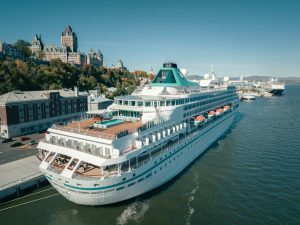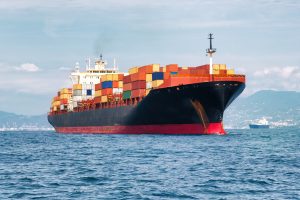By Leo Ryan, Editor
As this iconic historical photo shows, the beautiful tranquil town of Lanoraie, 60 kilometres northeast of Montreal, once had a great many visitors at anchor in the facing waters of the mighty St. Lawrence River.
The vessels were among the more than 300 that were idled between June 21 and July 14, 1968 as a result of a strike by the 1,250 members of the then Canadian Brotherhood of Railway, Transport and General Workers demanding an 18% pay increase over two years from Canada’s St. Lawrence Seaway Authority.
This was the first strike that had hit the North American waterway since it began operations in 1959. Losses in wages, Seaway tolls and marine industry revenues were estimated at the equivalent today of $4 million each day. Thus, roughly hundreds of millions of dollars for the 24-day stoppage.
But during that period one can imagine scores of Lanoraie’s 5,000 residents connecting with vessel crews by motorboat – bringing food and other supplies as the conflict dragged on. No doubt, too, ship chandlers from Montreal captured new provisional business.
Now again today, residents of Lanoraie and other communities on the St. Lawrence will be finding themselves suddenly in the company of ships waiting to enter the Seaway system to deliver cargoes to Quebec, Ontario and eight U.S. Great Lakes states. This stems from a strike launched early Sunday by 361 unionized Canadian Seaway workers after the breakdown of negotiations – with wage demands the key issue – with the St. Lawrence Seaway Management Corporation (SLSMC). At latest count by the SLSMC, more than 100 vessels outside the Seaway system are impacted by the situation.
Through the years, the two sides had managed to hammer out last minute deals to avert a strike deadline – which provided a significant stable environment for a maritime corridor increasingly competing against railways, coastal ports and the Mississippi barge system.
Otherwise, looking back, two major mechanical incidents have been the main causes of serious traffic disruption. In 1984, a lift bridge at Valleyfield, Quebec got stuck halfway for 18 days, backing up 160 Laker and ocean vessels. A year later, a 46-metre section of Lock 7 on the Welland Canal collapsed, closing the Canal for 24 days.
Photo credit: The photo taken by John Low of the Canadian Coast Guard was kindly made available to Maritime Magazine from the collection of St. Lawrence veteran photographer Marc Piché.








